Microbial or biological contamination is the most common type of food contamination. Microbial food contamination occurs when harmful living microorganisms are present unintentionally and pollute food. This contamination can lead to illness and food spoilage. Protect food from microbial contamination using microbial control methods; HACCP system, appropriate storage temperatures, and suitable food preservation methods.
What is Microbial Contamination of Food
Microbial or biological contamination is the presence of undesirable microorganisms. These microbes include bacteria, viruses, parasites, and fungi like moulds and yeasts that can lead to foodborne illnesses.

How To Protect Food from Microbial Contamination: Microbial Control Methods
Food safety protocols against microbial contamination include:
- Appropriate temperatures and hygiene
- Hazard analysis
- Proper storage
The Hazard Analysis and Critical Control Points (HACCP) System
Food businesses use this preventive system to identify and combat food contaminants. The HACCP approach performs the following tasks to protect food from microbial contamination:
- Conducts a hazard analysis
- Establishes critical control points (CCPs)
- Implements control measures
- Monitors procedures
- Maintains records to ensure the safety of food products
Food Hygiene Measures
Pathogens can spread rapidly through contaminated hands, utensils and equipment. This highlights the importance of food hygiene practices in food handling areas. To prevent unhygienic food handling, following these steps is necessary:
- hand washing with a medicated anti-bacterial soap
- wearing appropriate gear
- storing food correctly
- separating raw and ready-to-eat items
Food Preservation Methods
Preservation of food includes methods to slow down or kill bacterial growth to keep food fit for human consumption. Common food preservation methods are:
- Fridge Storage
- Freezer Storage
- Can Storage
- Vacuum Storage
- Salt Treatment
- Sugar Treatment
Cooking and Reheating Food at Appropriate Temperatures
Reheat food in microwaves or stove tops at a universally acceptable temperature of 165°F (74°C), for a duration of at least 2 minutes. Reheating leftover food reduces the risk of bacterial contamination and food poisoning.
For more information, visit our blog article, ‘Can You Reheat Pork?’
Keep Food Out of the “Danger Zone” Temperature
Food exposed to the danger zone temperature range promotes bacterial multiplication by two times. Keep food out of this temperature to prevent microbial contamination.
Proper Storage of Food
Bacteria survive in a wide range of environments and undergo rapid growth. Store leftover or cooked food in the fridge at below 5°C, for up to 3-4 days. Food should be stored in a refrigerator within 2 hours. If it stays exposed to warmer room temperatures, it becomes unfit for consumption and should be immediately discarded.
Get Online Food Safety Courses
Food Hygiene And Safety
Check the CourseRated Excellent
on major review sites

Impact of Microbial Food Contamination
Food polluted by pathogens can affect its safety and hygiene. Most importantly, it can impact health by causing gastrointestinal problems in people who eat contaminated food.
Food Poisoning:
Pathogenic bacteria such as E. coli and Salmonella are among the most well-known causes of severe diarrheal illnesses in humans. When these bacteria contaminate food, especially if consumed raw or undercooked, they can lead to food poisoning.
Symptoms of food poisoning include the following:
- Diarrhea
- Abdominal pain
- Nausea
- Vomiting
- Fever

Anti-palatability of Food:
Certain bacteria can produce organic acids during their metabolic processes, which can affect the pH levels of food. This change in acidity can impact the taste and texture of food.
Spoilage of Food:
Microbial contamination can alter the structure of food. Some bacteria produce enzymes that break down proteins, fats, and carbohydrates present in food. This leads to spoilage and changes in texture. For example, the slimy texture of spoiled meat can be due to microbial activity.
Sources of Microbial Contamination in Food
Microbes such as bacteria, viruses, fungi and their toxins find their way into food products. Microbial contamination can be caused by various sources:
Unhygienic Practices: One primary source of contamination is unhygienic practices during food production and processing. Examples include:
- Inadequate handwashing by food-handlers
- Use of contaminated equipment.
Inappropriate Cooking Temperatures: Improper cooking techniques or insufficient heat treatment allow bacteria like Salmonella and Campylobacter to survive. This can lead to potential health risks for consumers.
Water Pollution: Contaminated water used in irrigation or during food processing worsens the problem. It can transfer pathogens such as norovirus and E. coli. These microbes contaminate crops and ready-to-eat foods.
Improper Storage of Food: Inadequate storage conditions create favourable environments for microbial growth. This allows contamination to persist even after the production phase.
Global Significance of Microbial Contamination
Microorganisms present the greatest threat to food safety. According to the Centers for Disease Control and Prevention, approximately 250 foodborne diseases are linked to microorganisms, primarily bacteria and viruses.
Conclusion
Microbial contamination is the primary threat to food safety worldwide. Prevention of microbial contamination of food includes microbial control methods, primarily the HACCP approach and food preservation methods. Microbes have detrimental effects on both the quality of food and the health of consumers. Microbial or biological contamination results from the infiltration of harmful microorganisms like bacteria, viruses, fungi, and their related toxins into the food chain. The consequences of microbial contamination include food poisoning and spoilage.




